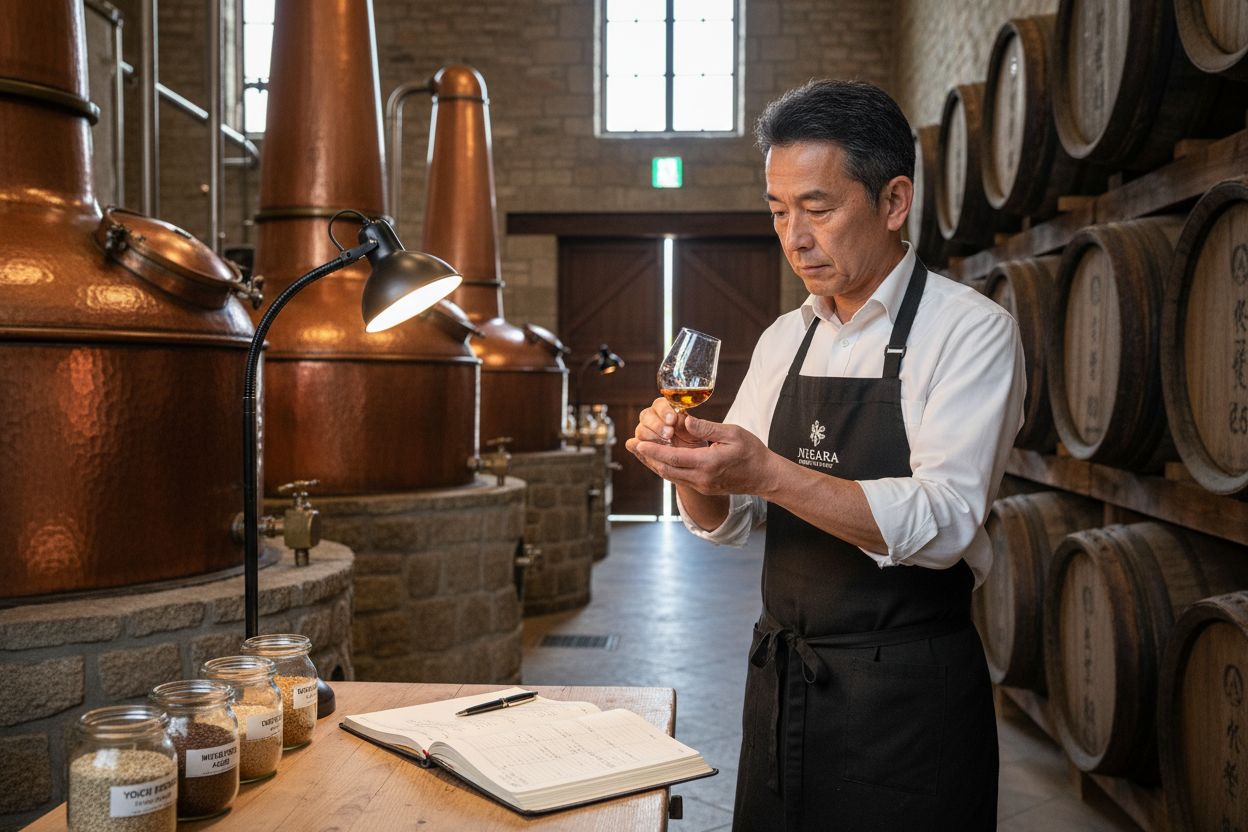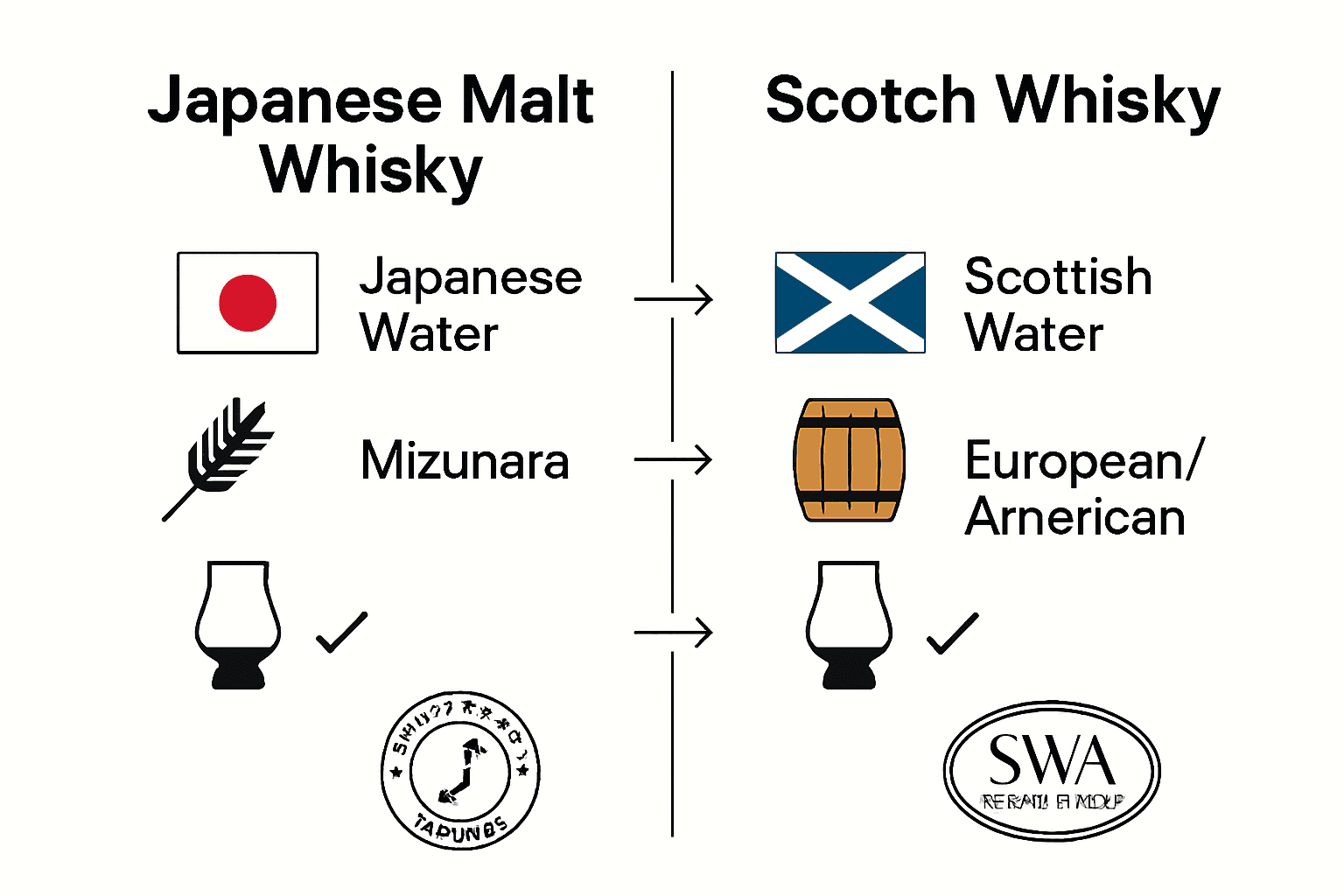Did you know that Japanese whisky has become so sought after that auction prices have soared by over 70 percent in the last decade? This remarkable spirit weaves together rich tradition and exacting craftsmanship, winning global respect for its unique style. With intricate flavors and a devotion to quality, Japanese malt whisky continues to influence connoisseurs and collectors worldwide while offering a story rooted in history and marked by innovation.
Key Takeaways
| Point | Details |
|---|---|
| Origin of Japanese Whisky | Japanese malt whisky began in the late 19th century, evolving through the influence of pioneers like Shinjiro Torii and Masataka Taketsuru. |
| Production Standards | The Japan Spirits & Liqueurs Makers Association (JSLMA) enacted strict standards in 2021 to ensure authenticity, requiring all production to occur in Japan. |
| Aging and Flavor Profiles | Unique aging processes using Mizunara oak and a focus on delicate flavor profiles distinguish Japanese whisky from Scotch counterparts. |
| Collector Awareness | The introduction of JSLMA certification logos helps collectors identify genuine Japanese whisky, emphasizing the importance of transparency in marketing. |
Table of Contents
- Defining Japanese Malt Whisky And Its Origins
- Production Process And Key Ingredients Explained
- Distinctive Flavor Profiles And Regional Styles
- Legal Standards And Classification Criteria
- Comparing Japanese Malt And Scotch Whisky
- Common Misunderstandings And Collecting Tips
Defining Japanese Malt Whisky and Its Origins
Japanese malt whisky represents a fascinating journey of craft, tradition, and innovation that began in the late 19th century. According to historical research, whisky production in Japan emerged around 1870, with the pivotal moment arriving in 1923 when the first commercial distillery opened in Yamazaki. Two pioneering figures stand at the heart of this story: Shinjiro Torii and Masataka Taketsuru, who would fundamentally transform Japan’s approach to whisky making.
Taketsuru’s journey was particularly remarkable. He travelled to Scotland, studying Scotch whisky production techniques that would later become foundational to Japanese whisky crafting. After returning to Japan, he founded Nikka in 1934, bringing sophisticated Scottish distillation methods into the Japanese whisky landscape. Learn more about Japanese whisky styles and how these early pioneers shaped an entire industry.
The Japanese malt whisky market initially focused heavily on blended varieties, with blends comprising over 90% of production volume for many years. Today, single malts and blended malts have gained significant prominence, with major producers like Suntory (featuring renowned distilleries Yamazaki and Hakushu) and Nikka leading global recognition. What sets Japanese malt whisky apart is its meticulous attention to detail, precision in crafting, and a unique interpretation of Scottish whisky traditions refined through a distinctly Japanese lens of artisanship and perfectionism.
Production Process and Key Ingredients Explained
Japanese malt whisky production represents a delicate art of precision and tradition, rooted in meticulous crafting techniques. According to research from the Japan Policy Forum, the fundamental process begins with malted barley, which is carefully processed through traditional pot stills - a method that distinguishes Japanese whisky from other global styles. Single malt production requires 100% malted barley, ensuring a pure and refined spirit that captures the essence of its ingredients.
The distillation process is where Japanese whisky truly shines. Distillers use two distinct still types: pot stills for malt whisky and column stills for grain whisky. This nuanced approach allows for remarkable complexity and depth of flavor. Explore Japanese whisky production techniques and discover the intricate methods that make these spirits world-renowned.
One of the most distinctive aspects of Japanese malt whisky is its unique aging process, particularly the use of Mizunara oak casks.
 These indigenous Japanese oak barrels impart extraordinary characteristics to the whisky, creating a flavor profile that is distinctly sweet and light-bodied. While traditional Scotch whisky uses predominantly European or American oak, Japanese distillers leverage their local wood to create a truly unique sensory experience that sets their whiskies apart on the global stage.
These indigenous Japanese oak barrels impart extraordinary characteristics to the whisky, creating a flavor profile that is distinctly sweet and light-bodied. While traditional Scotch whisky uses predominantly European or American oak, Japanese distillers leverage their local wood to create a truly unique sensory experience that sets their whiskies apart on the global stage.
Distinctive Flavor Profiles and Regional Styles
Japanese whisky stands out globally for its remarkable diversity and nuanced flavor profiles. According to research from Le Dom du Vin, these whiskies characteristically differ from Scotch by presenting lighter, more delicate characteristics with pronounced floral, fruity, and spicy undertones. The unique climate and specialized production techniques contribute to a distinctly sophisticated drinking experience that sets Japanese whiskies apart from their international counterparts.
Each renowned Japanese distillery offers a signature flavor profile that reflects its regional origins and crafting philosophy. Discover the unique characteristics of Japanese whisky styles to appreciate the nuanced differences. For instance, Yamazaki is celebrated for its complex fruity notes, while Hakushu presents a light, herbal profile with subtle peaty hints. Nikka Yoichi represents the smokier end of the spectrum, delivering robust, peated expressions that challenge traditional expectations.
The Mizunara oak, a distinctive element of Japanese whisky production, plays a crucial role in developing these extraordinary flavor profiles. These indigenous Japanese oak casks impart an extraordinary incense-like quality, creating whisky experiences that are simultaneously familiar and entirely unique. From the smooth, floral layers of Hibiki to the elegant, fruity expressions of Miyagikyo, Japanese whisky offers a sensory journey that reflects both traditional craftsmanship and innovative spirit-making techniques.
Legal Standards and Classification Criteria
The landscape of Japanese whisky has undergone significant legal transformation, with the Japan Spirits & Liqueurs Makers Association (JSLMA) establishing comprehensive criteria to protect the integrity and reputation of Japanese whisky production. According to recent research, these standards, introduced in 2021, set clear guidelines defining what can authentically be labeled as Japanese whisky, ensuring transparency and quality for consumers worldwide.
The JSLMA’s stringent criteria encompass several critical requirements. Learn more about Japanese whisky regulations to understand the intricate standards. Key specifications include mandatory fermentation, distillation, and maturation within Japan, with a minimum aging period of three years. Producers must use malted grains and Japanese water, with distillation limited to under 95% alcohol by volume (ABV). Bottling must occur in Japan, with a minimum bottling strength of 40% ABV, and only plain caramel coloring is permitted.
Looking towards 2025, the JSLMA is actively working to make these standards legally binding, introducing a certification logo that will help consumers easily identify authentic Japanese whisky. This move represents a significant step in preserving the craftsmanship, heritage, and global reputation of Japanese whisky. By establishing these rigorous standards, Japanese whisky producers are not just creating a legal framework, but also reinforcing their commitment to exceptional quality and traditional distillation practices.
Comparing Japanese Malt and Scotch Whisky
Japanese whisky and Scotch share a profound historical connection, with Japanese distillers initially drawing inspiration directly from Scottish whisky-making traditions. According to research from Paste Magazine, both styles utilize double copper pot stills and offer similar formats of single malts and blends. However, a crucial distinction emerges in production approach: Japanese distilleries like Yamazaki demonstrate remarkable versatility, producing multiple whisky variations within a single site - a practice less common in traditional Scotch production.
Explore the nuanced world of whisky styles and uncover the subtle differences that make each tradition unique. The fundamental divergence lies in their philosophical approach to whisky crafting. Where Scotch whisky often emphasizes regional characteristics and peaty profiles, Japanese whisky prioritizes refinement, balance, and delicate flavor expressions. The climatic differences play a significant role - Japan’s hot summers and cold winters create distinct aging conditions that contribute to lighter, more elegant spirit profiles.
The aging process represents another fascinating point of differentiation. Japanese distilleries frequently use Mizunara oak, an indigenous Japanese wood that imparts unique incense-like and sandalwood notes, contrasting sharply with the traditional European or American oak used in Scotch production. This commitment to local materials and nuanced crafting techniques demonstrates how Japanese whisky has evolved from mere Scottish emulation to a sophisticated, internationally acclaimed spirit with its own distinct identity.

Here’s a comparison of Japanese malt whisky versus Scotch whisky:
| Feature | Japanese Malt Whisky | Scotch Whisky |
|---|---|---|
| Key Ingredients | Malted barley Japanese water |
Malted barley Scottish water |
| Distillation Method | Copper pot stills Column stills |
Copper pot stills |
| Common Oak Types Used | Mizunara (Japanese) oak American/EU oak |
American/EU oak |
| Typical Flavour Profile | Light, delicate Floral, fruity, spicy |
Robust, peaty Malty, smoky, woody |
| Regional Focus | Refined, balanced, precision | Regional variation, terroir-driven |
| Climate Impact | Hot summers & cold winters Lighter spirit |
Temperate climate Heavier spirit |
| Regulatory Standards | JSLMA strict criteria 3 years min aging |
Scotch Whisky Regulations 3 years min aging |
Common Misunderstandings and Collecting Tips
Japanese whisky has long been surrounded by misconceptions, particularly regarding its authenticity and production standards. According to research from Time Out Tokyo, prior to 2021, many whiskies marketed as Japanese were actually blends of imported spirits simply bottled in Japan. The Japan Spirits & Liqueurs Makers Association (JSLMA) introduced critical standards to address this issue, though full enforcement remains voluntary until 2024.
Discover authentic Japanese whisky collecting strategies to navigate this complex market. For serious collectors, the key is understanding the new certification requirements. The JSLMA certification logo has become the gold standard for verifying genuine Japanese whisky. This means the entire production process - from fermentation to bottling - must occur in Japan, using Japanese water and malted grains, with a minimum three-year maturation period.
Collectors should be particularly cautious about misleading marketing practices. The new regulations strictly limit the use of Japanese cultural references, images, and terminology for products that do not meet the authentic production standards. This means that a whisky bottle featuring Japanese imagery or words no longer guarantees its Japanese origin. Smart collectors now look for the official JSLMA certification, research the distillery’s production methods, and understand that true Japanese whisky represents a meticulous craft far beyond mere geographical labeling.
Discover Authentic Japanese Malt Whisky with Confidence
Craving the authentic taste of Japanese malt whisky but overwhelmed by confusing labels and uncertain sourcing? With tightening standards and the new JSLMA certification, it can feel risky to invest in a bottle without assurance of its true origins. The article above spotlights how complex flavour profiles, unique production techniques like Mizunara oak ageing, and strict legal standards distinguish genuine Japanese whisky from imitations. If you want certainty and variety when starting your collection or searching for your next rare dram, you deserve a trusted destination.

Visit Uisuki.com.au and shop with confidence, knowing every bottle is carefully curated with clear origins and detailed descriptions. Want to explore more about Japanese whisky styles and regulations before you buy? Check out our expert guides right on our website, or browse our range now and secure limited releases before they disappear. Start your journey today at Uisuki.com.au for the genuine Japanese malt whisky experience you have been searching for.
Frequently Asked Questions
What is Japanese malt whisky?
Japanese malt whisky is a type of whisky produced in Japan using malted barley, primarily crafted through traditional pot stills. It is known for its light, delicate flavor profiles and meticulous production methods that incorporate both traditional Scottish techniques and unique Japanese practices.
How does Japanese malt whisky differ from Scotch whisky?
While both types utilize similar ingredients and distillation methods, Japanese malt whisky is characterized by its refinement and balance, often presenting lighter and more delicate flavors. The use of Mizunara oak for aging also sets it apart, imparting unique flavor notes not typically found in Scotch whisky.
What are the main ingredients used in Japanese malt whisky production?
The primary ingredients in Japanese malt whisky production are malted barley, Japanese water, and specific yeast strains. The combination of these elements, along with traditional distillation processes, contributes to the whisky’s distinctive flavor and quality.
What are the legal standards for labeling Japanese whisky?
The Japan Spirits & Liqueurs Makers Association (JSLMA) mandates that Japanese whisky must undergo fermentation, distillation, and aging within Japan, with a minimum aging period of three years. Only whisky produced with malted grains and Japanese water can be labeled as Japanese whisky, ensuring authenticity and quality.

